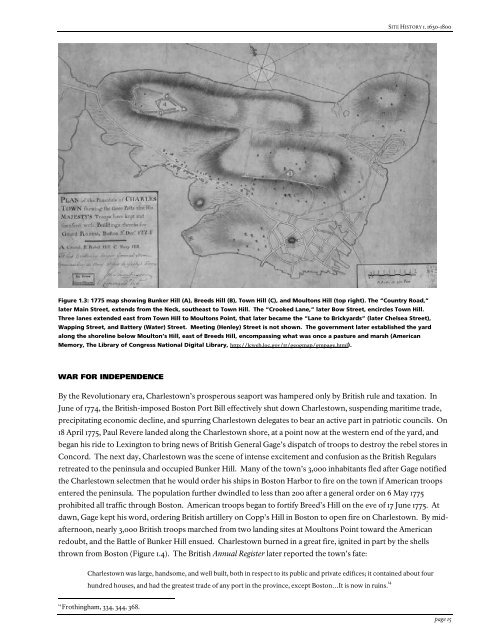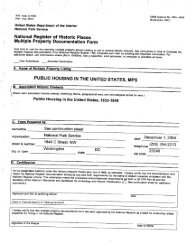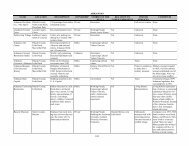Cultural Landscape Report for Charlestown Navy Yard, Boston
Cultural Landscape Report for Charlestown Navy Yard, Boston
Cultural Landscape Report for Charlestown Navy Yard, Boston
You also want an ePaper? Increase the reach of your titles
YUMPU automatically turns print PDFs into web optimized ePapers that Google loves.
SITE HISTORY 1. 1630-1800<br />
Figure 1.3: 1775 map showing Bunker Hill (A), Breeds Hill (B), Town Hill (C), and Moultons Hill (top right). The “Country Road,”<br />
later Main Street, extends from the Neck, southeast to Town Hill. The “Crooked Lane,” later Bow Street, encircles Town Hill.<br />
Three lanes extended east from Town Hill to Moultons Point, that later became the “Lane to Brickyards” (later Chelsea Street),<br />
Wapping Street, and Battery (Water) Street. Meeting (Henley) Street is not shown. The government later established the yard<br />
along the shoreline below Moulton’s Hill, east of Breeds Hill, encompassing what was once a pasture and marsh (American<br />
Memory, The Library of Congress National Digital Library, http://lcweb.loc.gov/rr/geogmap/gmpage.html).<br />
WAR FOR INDEPENDENCE<br />
By the Revolutionary era, <strong>Charlestown</strong>’s prosperous seaport was hampered only by British rule and taxation. In<br />
June of 1774, the British-imposed <strong>Boston</strong> Port Bill effectively shut down <strong>Charlestown</strong>, suspending maritime trade,<br />
precipitating economic decline, and spurring <strong>Charlestown</strong> delegates to bear an active part in patriotic councils. On<br />
18 April 1775, Paul Revere landed along the <strong>Charlestown</strong> shore, at a point now at the western end of the yard, and<br />
began his ride to Lexington to bring news of British General Gage’s dispatch of troops to destroy the rebel stores in<br />
Concord. The next day, <strong>Charlestown</strong> was the scene of intense excitement and confusion as the British Regulars<br />
retreated to the peninsula and occupied Bunker Hill. Many of the town’s 3,000 inhabitants fled after Gage notified<br />
the <strong>Charlestown</strong> selectmen that he would order his ships in <strong>Boston</strong> Harbor to fire on the town if American troops<br />
entered the peninsula. The population further dwindled to less than 200 after a general order on 6 May 1775<br />
prohibited all traffic through <strong>Boston</strong>. American troops began to <strong>for</strong>tify Breed’s Hill on the eve of 17 June 1775. At<br />
dawn, Gage kept his word, ordering British artillery on Copp’s Hill in <strong>Boston</strong> to open fire on <strong>Charlestown</strong>. By midafternoon,<br />
nearly 3,000 British troops marched from two landing sites at Moultons Point toward the American<br />
redoubt, and the Battle of Bunker Hill ensued. <strong>Charlestown</strong> burned in a great fire, ignited in part by the shells<br />
thrown from <strong>Boston</strong> (Figure 1.4). The British Annual Register later reported the town’s fate:<br />
<strong>Charlestown</strong> was large, handsome, and well built, both in respect to its public and private edifices; it contained about four<br />
hundred houses, and had the greatest trade of any port in the province, except <strong>Boston</strong>…It is now in ruins. 14<br />
14<br />
Frothingham, 334, 344, 368.<br />
page 15







